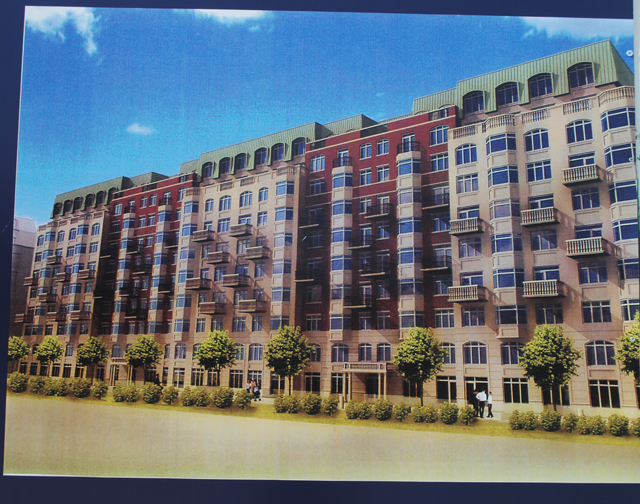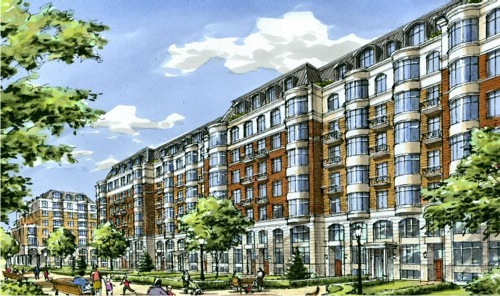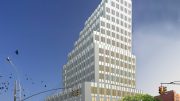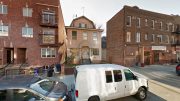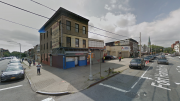The churn of new construction in Borough Park, Brooklyn’s largest ultra-Orthodox Jewish neighborhood, is constant, usually involving developers tearing down single-family detached homes and replacing them with small walk-up apartment buildings. But at 886 Dahill Road, on the border of Borough Park and Mapleton, something much bigger may soon rise.
Some drawings of the building planned for 886 Dahill have already circulated, but a rendering has gone up on the construction fencing of the latest 10-story iteration, designed by Karl Fischer. It’s a three-dimensional version of the earlier drawing, but with a distinctly Hasidic addition: diagonally-arranged balconies. As with most new buildings catering to the community (and even some old ones), the balconies are placed such that as many apartments as possible can erect their Sukkot booths directly under the stars, as their religion dictates.
Because 886 Dahill is located in a previously industrial area – along the LIRR’s Bay Ridge Branch freight line, and near the rattling Culver Line elevated structure that now hosts F train service – the land was zoned exclusively for commercial and industrial uses, and building housing required a rezoning.
Normally rezoning old industrial land would be a tough, politicized slog, involving affordable housing and density concessions by the developer. But nobody delivers votes quite like the rebbes, as the local political saying goes, and accommodating growth is arguably the primary political goal of the Hasidic community.
The rezoning was granted in February 2008, and plans were filed the next year for a building with 171 units. Spread over 310,000 square feet, it will be one of the largest Hasidic buildings in Brooklyn, with a very family-friendly average apartment size of 1,800 square feet. According to the application, it would have 18 five-bedroom units and 55 four-bedrooms. It will also have around 230 parking spaces. This is an unusually high number for a Hasidic building (which usually have none) that could have been either the developer’s choice (because the building is so high-end), or imposed by politicians when approving the project.
Developers Edward and Martin Wydra apparently ran into some trouble, though, and at one point tried to sell the project. But in 2013 they started filing for permits again, and a new rendering on site usually portends movement (though the person who answered the phone at their office pleaded ignorance when asked about construction).
More generally, the rezoning and the development raise the question of what to do with the rest of the “M”-zoned land along beneath the elevated Culver Line.
Before World War II, the clamor of the el (and, at one point, its steam-belching trains) kept the area largely industrial, and the 1961 zoning code enshrined that use. Today, some manufacturing remains – YIMBY saw a few garment workers toiling away inside one of the buildings on McDonald Avenue.
But most of the land now is occupied by warehouses and wholesalers with low job densities, or non-industrial commercial uses that could just as well exist at the bases of new apartment buildings. Meanwhile, housing has grown much scarcer, and residential builders would likely gradually outbid everyone else on McDonald Avenue, if they had the chance.
Residential property in this area, and especially right beneath an elevated train, is nowhere near valuable enough for the city to extract below-market housing out of developers in exchange for residential rezonings. As a result, it’s not likely to be of immediate interest to de Blasio’s housing team, who seem to be focused on encouraging growth in areas pricey enough to extract such concessions.
But that doesn’t mean the Department of City Planning should ignore McDonald Avenue and areas like it. Market-rate housing in this corner of New York City is relatively affordable – brand new condos in Hasidic buildings in adjacent Borough Park go for $400 per square foot or less, a third the price of Williamsburg – and the F train in Brooklyn is not at capacity. The city should rezone McDonald Avenue to also allow mid-rise mixed-use development as soon as possible, before rents continue their upward spiral.
Talk about this project on YIMBY Forums
For any questions, comments, or feedback, email [email protected]
Subscribe to YIMBY’s daily e-mail
Follow YIMBYgram for real-time photo updates
Like YIMBY on Facebook
Follow YIMBY’s Twitter for the latest in YIMBYnews

